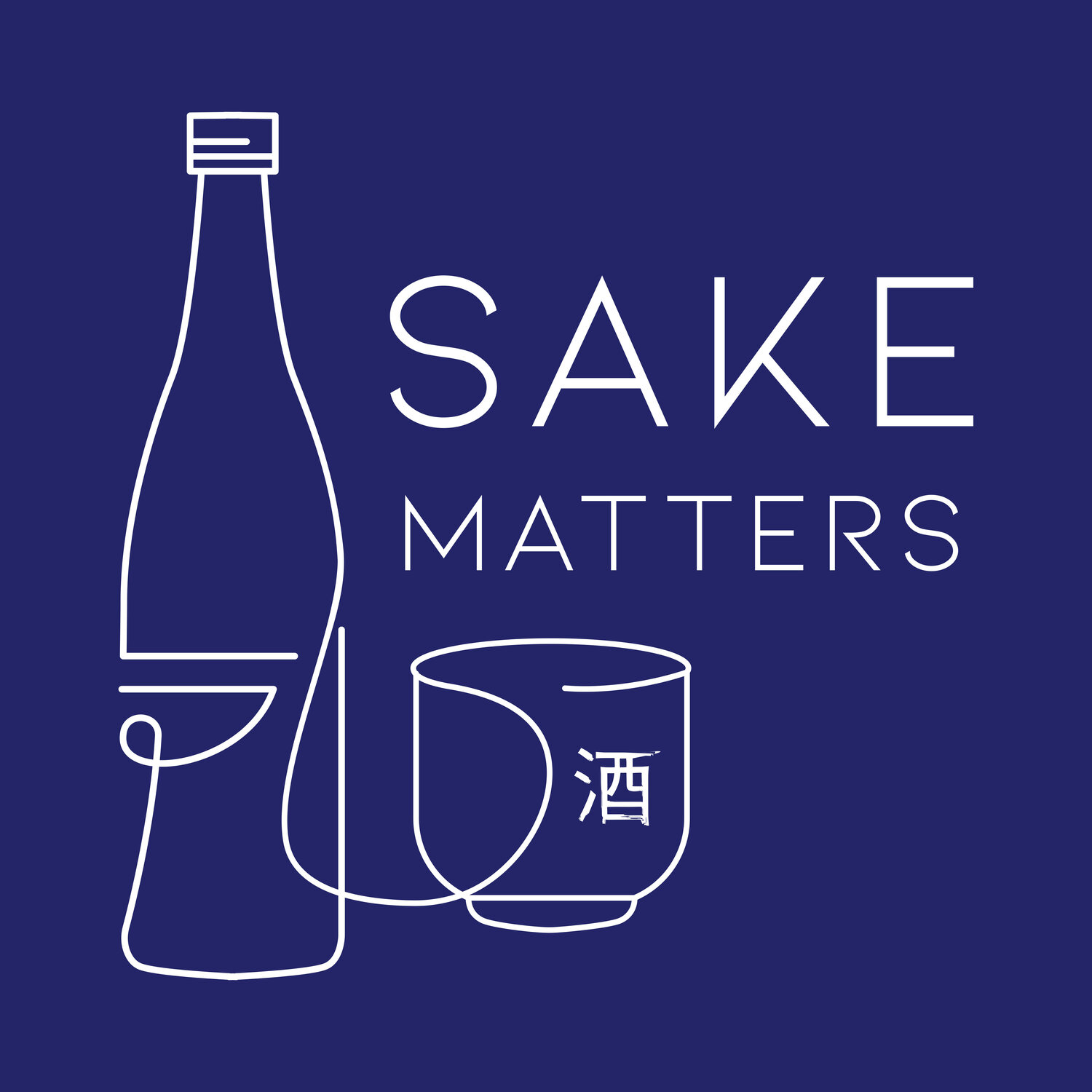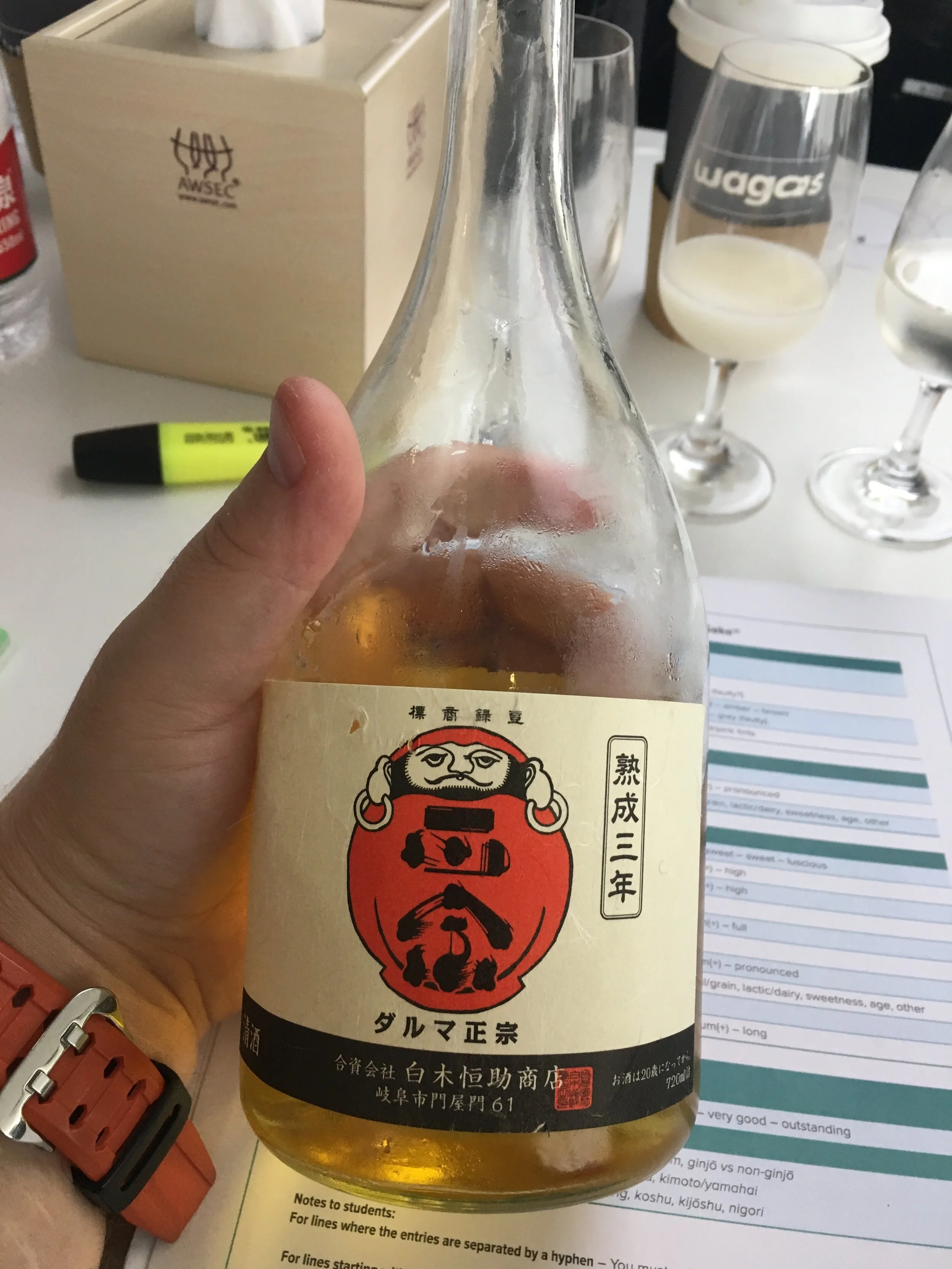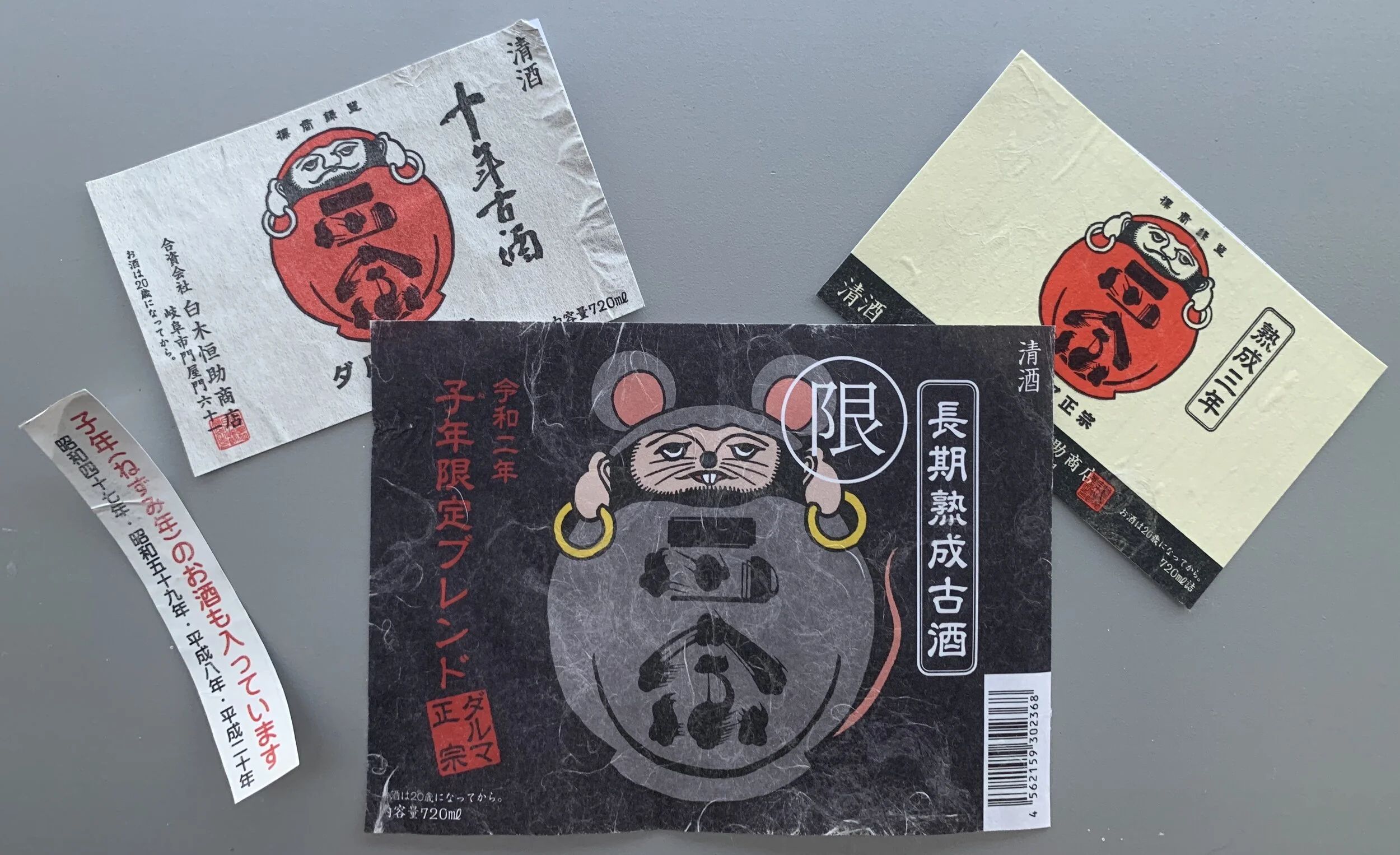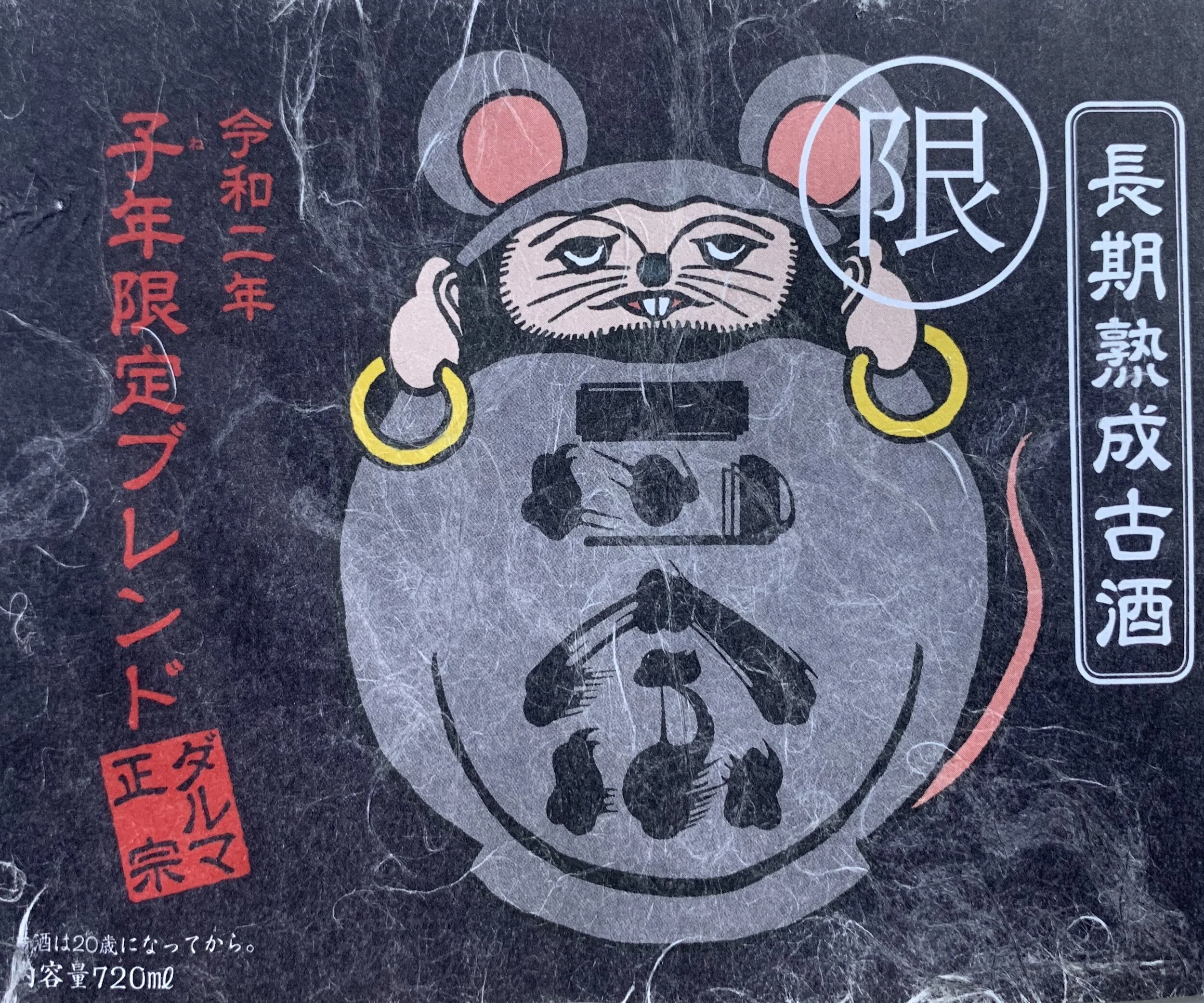RATFACED
A few weeks back I inadvertently blurted out a phrase that has made me giggle a few times ever since: ratfaced. Possibly on the cusp of being a little ratfaced myself, I employed this wonderful epithet to categorise all those revellers pouring en masse out of Britain’s pubs, choosing to sport their beer-soaked face masks as a chin warmer or avant garde jewellery accessory. Hope you all had a good night…
Whatever the circumstances, it stuck with me and so I was delighted to be confronted by this wonderful ratfaced labelling from Daruma Masumune. Isn’t it great?
All you need to know about this blend right there
First things first, Sake is predominantly made, shipped and sold to be enjoyed within twelve months. Shigeri Shiraki, seventh generation Kuramoto and husband, Toji Hitoshi Shiraki, and previously father Yoshiji Shiraki, have been bucking the trend since 1971 to focus solely on Koshu, aged Sake.
In fact strictly Koshu 古酒 is more properly known as Choki Jukusei-shu 長期熟成酒 which literally translates to long term aged Sake. It’s possible that inadvertently aged Sake could be categorised as Koshu, whose quality is less than admirable. Deliberately curated long-term aged Sake should be held up proudly as Choki Jukusei-shu.
Before we move on, I want to say that aged Sake is brilliant (in my opinion) but also let me reiterate it is just a fraction of the market. As ever production methods vary massively, there’s no quintessential recipe as such and it can be off putting to some and so far removed from fresh Sake that people just don’t want it.
And that’s their loss I think. It’s a wonderful aperitif, digestif and goes so well with big ass rich meat dishes, cheeses, desserts and chocolates.
The Shiraki Brewery in Gifu Prefecture is landlocked, and surrounded by mountains and rivers, not unlike many Kura in Japan. It’s a family, small production affair and has been in operation since 1835 so falls into I guess the ‘middle aged’ category for Japan’s breweries.
Their brand Daruma Masamune has one of the more iconic labels. When I first tried it, a few years back during one Sake education programme, I quickly fell in love with the slightly grumpy and portly pirate staring me out from the label. I also, I imagine, told a few folk about him, clinging on to any early knowledge to appear more in tune with the Sake industry than perhaps I was at the time.
My first taste of Daruma Masamune
And here’s the rub, he’s not a pirate, so let me introduce you quickly to the daruma doll.
Following a significant earthquake in 1891, Shiraki Brewery turned to Bodhidharma, the founder of the Zen tradition of Buddhism, and his depiction as a daruma doll. The dolls take many forms but generally manifest as a bearded man, very often sporting red attire, although regional variations abound.
The brewery’s take on the daruma doll
The key thing here is that this doll has become a symbol of perseverance and rising back up from adversity. That’s a crass simplification of the macabre and gruesome tales that surround the tribulations of monk Bodhidharma but it’s all you need to know for this piece. To sugar coat it even more, think of the daruma doll as you would the roly-poly toy from the 70s: Weebles. How did the marketing go again?
Weebles wobble, but they don't fall down
Shigeri-san expresses the relevance to the brewery more poetically with:
Although it falls over, it always rises
You get the picture I’m sure. Anyway, this isn’t a cultural piece, let’s get back to the Sake.
Unlike today, Koshu was big business and de rigeur for centuries from 13th century Kamakura until 19th century Edo periods actually but new regulations became a punitive thorn in the side of brewers with the requirement that taxes be paid at the time of production rather than the time of sale. Prolific Koshu brewers would therefore be faced with paying out well in advance of receiving sales revenue for their products. Cash flow has always been king it seems.
Thankfully, almost 50 years back in 1971 the laws changed and the Shiraki family set about a courageous plan to revive Koshu, believing that having a traditional product in a modern market would be a unique enough proposition to garner sufficient interest and remuneration. It seems clear now that this wasn’t a bad call at all.
Image from https://www.daruma-masamune.co.jp (with thanks)
Without recipe but instead relying on using trial and error, things started to go right. One of their keys to aging lies in the 70% seimaibuai which leaves plenty of suitable aging nutrients and compounds in addition to the core starch itself, not least amino acids which bump up the umami levels and sugars which help achieve such dark colourations. In addition, a rustic table rice is used, Nihonbare, which is bereft of the delicate aroma producing compounds more suitable to Ginjo production which tend not to mature so well.
In essence we’re talking about a rough diamond here. There’s a rough and readiness to this key ingredient that in the right hands, with the benefit of time, produces something quite extraordinary. Maturing temperatures from 5°C to 27°C - varying across the seasons - also accelerates the aging process in an environment quite beyond the modern -5°C trend that we’re seeing today. Shiraki Shuzo doesn’t have a refrigerator. If any cooling is needed, water is sprayed on the tanks.
The three year, a mere baby by Daruma Masamune standards, shows maturity beyond its age with light cocoa notes, a sweet nuttiness and dried mango. Acidity is high and it is noticeably thinner than it’s ten year old big brother. But there’s hints of things to come with a kind of bonfire toffee smokiness and savoury broth. A good start.
My Koshu collection, what’s left of it
What effects will seven more years have then? The colour of the ten year old is an orange brown, no mistaking that this is Choki Jukusei-shu. The chocolate this time is dark, and there’s coffee bean or espresso bitterness. Bitter caramel and fresh tar (love these aromas) add to the richness, and that smell of tarmac roads after a rain shower, kind of heady and musty. Finally the bitter sweet flavor of a semi-burnt raisin on top of a fruit cake. Perhaps a bit niche but Christmas is coming. Ooh, this ten year would go so well with Christmas cake and a slice of aged Cheddar cheese.
All this from table rice? Incredible.
I’ll be glad to see the back of 2020’s Year of the Rat but you can’t deny this is a corking label
I’ll sign off with the Ratface label, where this blog began. First of all, great label. I have meticulously peeled him off for my scrapbook.
Proudly the bottleneck label announces Choki Jukusei Koshu, also 限 ‘Limited Edition’ and it truly is as this is a special blend for multiple Years of the Rat - 2008 (Heisei 20), 1996 (Heisei 8), 1984 (Showa 59) and 1972 (Showa 47). Incredible, and what a privilege. We’re in Champagne or Scotch Whisky territory here with all this blending going on and it’s such fun.
It’s no surprise then that a great range of flavours sing out here, ranging from bitterness with a slightly burnt sugar that’s caught on the pan, through to a smooth honeyed mocha coffee. It’s complex, layered and well integrated.
And that’s where the problem lies - it was gone before I knew it, before I even took a snap of it in glass. I’m not a big fan of vermin but I’ll be seeking out another Year of the Rat blend as soon as I can.
Masamune Daruma, keep being different, keep experimenting and don’t bother with recipes. You have well and truly bounced back!
FOOTNOTE:
These awesome Sakes were shared with me in time for World Sake Day by Asian Skyway Limited, a newly formed Sake business in Hong Kong. For further information please contact Ivan Sean on +852 9380 3803.
The three and ten year Sakes are a blend of Junmai and Honjozo, both using 100% Nihonbare rice milled to 70% and fermented with K-7 yeast.
QUICK GLOSSARY:
Toji: Master Brewer with ultimate responsibility for brewing and the leadership of the brewing team
Koshu: General term for aged Sake
Choki Jukusei-shu: Long term aged Sake
Kura: Sake brewery
Seimaibuai: The percentage of rice remaining after the polishing process compared to its original weight (so a 60% seimaibuai reflects that 40% has been polished away)
Ginjo 吟醸: Sake made from rice at a polishing ratio below 60%
Heisei & Showa: The traditional Japanese calendar is based on the reign period of the emperor
LINKS:
Shiraki Brewery
www.daruma-masamune.co.jp
058-229-1008
61 Kadoyakado, Gifu City, Gifu Prefecture 501-2528













